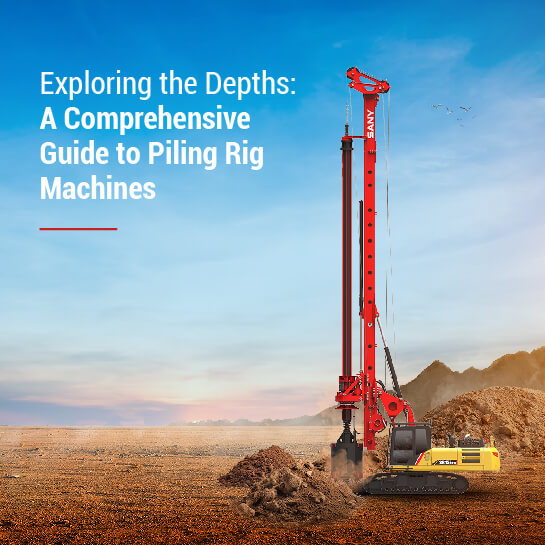Exploring the Depths: A Comprehensive Guide to Piling Rig Machines

In the world of modern construction, piling rigs are essential tools that help lay strong and stable foundations for buildings, bridges, and other large-scale infrastructure. Understanding how these machines work is crucial for ensuring project safety, efficiency, and cost-effectiveness. Whether you're a contractor, engineer, or project manager, knowing the ins and outs of piling rigs can make a big difference in your construction outcomes.
This article explores the key aspects of piling rigs, from their types and functions to the machinery involved and their critical role in today’s construction industry. Whether you're new to the field or looking to deepen your knowledge, this guide provides valuable insights into one of the most important pieces of equipment in construction.
What Are Piling Rigs?
Piling rigs are heavy-duty machines used to install piles—long, vertical support structures—into the ground. These machines are designed to drive, bore, or extract piles depending on the project requirements. They play a vital role in creating solid foundations that can withstand the weight of structures and environmental stresses. By mastering the use of piling rigs, construction professionals can enhance the quality, speed, and safety of foundation work.
Types Of Piling Rigs
There are several types of piling rigs, each suited for different conditions and applications:
- Driven Piling Rigs: These rigs use impact or vibration to drive piles into the ground. They are ideal for cohesive soils and deep foundations.
- Bored Piling Rigs: These rigs drill holes into the ground and then fill them with reinforced concrete. They are commonly used in urban areas or where large-diameter piles are needed.
- Micro Piling Rigs: Smaller and more maneuverable, these rigs are perfect for tight spaces such as city centers or existing structures where traditional rigs cannot operate.
Key Functions of Piling Rigs
Piling rigs serve multiple purposes in construction projects, including:
Pile Installation: Installing piles deep into the ground to provide structural support and stability for buildings, roads, and bridges.
Foundation Preparation: Ensuring that piles are placed at the correct depth and spacing to distribute loads evenly and prevent settlement.
Soil Testing: Conducting tests to evaluate soil conditions and determine the best pile type and installation method for the site.
Load Testing: Verifying the strength and performance of piles under various load conditions to ensure long-term safety and durability.
Environmental Compliance: Using eco-friendly drilling fluids and following sustainable practices to reduce the environmental impact of construction activities.
Components of a Piling Rig
A typical piling rig consists of several key components that work together to perform its tasks effectively:
- Base Machine: The main frame that supports the entire structure and provides stability during operations.
- Mast or Boom: A vertical or angled structure that holds the drilling or driving equipment and allows for precise positioning of piles.
- Drilling/Driving Attachment: This part includes hammers, augers, or rotary drills, depending on the pile type and soil condition.
- Control System: An advanced interface that allows operators to monitor and adjust parameters like rotation speed, torque, and feed rate for optimal performance.
The Role of Piling Rigs in Modern Construction
Piling rigs are essential in modern construction due to their ability to handle complex foundation challenges efficiently. Their importance lies in:
- Structural Integrity: Ensuring that piles are installed correctly to support the weight of structures and prevent failure over time.
- Versatility: Adapting to different soil types and construction needs, making them suitable for both small and large-scale projects.
- Time and Cost Efficiency: Speeding up the foundation process while maintaining high-quality results, reducing overall project timelines and expenses.
- Safety: Equipped with features that protect workers and ensure safe operation even in challenging environments.
- Technological Advancements: Incorporating smart systems and automation to improve accuracy, reduce human error, and increase productivity.
Conclusion
In the ever-evolving construction industry, piling rigs are indispensable tools that enable the creation of strong and durable foundations. From urban developments to large infrastructure projects, these machines are at the heart of modern construction efforts. As technology continues to advance, piling rigs will become even more efficient, safe, and environmentally friendly, further enhancing their value in the field.
If you're looking for reliable and high-performance piling rigs for your next project, consider Sany India as your trusted partner. As a leading manufacturer of piling rigs in India, we offer a wide range of machines, including models with stroke lengths from 3000 mm to 6000 mm. Our pile drilling machines can reach depths of up to 94 meters, making them suitable for a variety of construction needs. With over 21 years of experience in manufacturing construction equipment, we have built a strong network of 42 dealers and 260 touchpoints across the country. Whether you need a compact micro piling rig or a heavy-duty driven piling machine, Sany India has the right solution for you.
Water Soluble Fertilizer,Liquid Amino Acid Fertilizer,Top Dressing Fertilizer,Chelated Trace Minerals
Yantai Hongyuan Bio-fertilizer Co.,Ltd. , https://www.hongyuanlinong.com